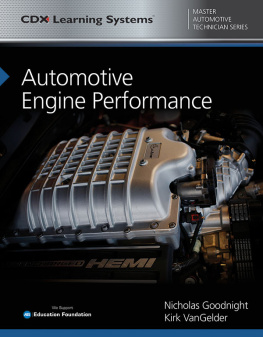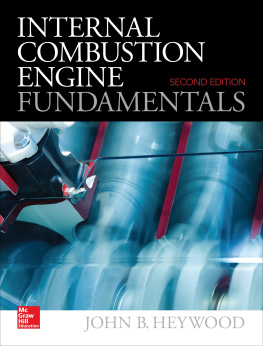How to Build and Modify
GM LS-Series Engines

By Joseph Potak

Contents
Acknowledgments
Special thanks to:
Brian Nutter, Wiseco Pistons
Joe Hughes, Wiseco Pistons
Laura Johnson, Wiseco Pistons
George Rumore, Kooks Custom Headers
Randy Becker, Harland Sharp
Kurt Urban, Kurt Urban Performance
Nick Norris, Callies and Compstar
Steve Demirjian, Race Engine Development
Brian Tooley, Total Engine Airflow and Trick Flow Specialties
Jason Mangum, Precision Race Components
Tracy Dennis, Sunset RaceCraft
Georgia Crouch, Image Editing and Touchups

Introduction
The LS1 5.7-liter V-8 began production more than 10 years ago, but many people and even some engine shops still are intimidated by the Gen-III and -IV family of engines. Fact is, its unlike any V-8 engine GM has released in the past. Even though it is no longer new, its still quite unfamiliar to many.
The first LS1s were released the year after the limited-run LT4 debuted, which at that time was the modern marvel of the SBC world. In retrospect, the LT4 didnt last long before being dethroned. While the differences between the Gen-II LT1 and LT4 were mostly external compared to the traditional small-block 350-cubic-inch, the Gen-III used all new architecture and components. Therefore, there are no carryover parts between the Gen-III and its predecessors.
The all-new fifth-generation Corvette received the new LS1 engine package in 1997, while the F-body platform (Camaro and Firebird) got it the following year. The 1997 Corvettes 5.7-liter LS1 was rated at 345 horsepower, and the 1998 F-body 5.7-liter LS1 was conservatively rated at 305 horsepower. Ironically, there are minimal differences between the two, considering the huge horsepower rating difference. The horsepower rating was either underrated due to insurance issues, or it was thought that the Corvette was given the higher numbers to justify the $20,000 price difference. Since then, there have been many improvements and refinements to these engines. The 405-horsepower LS6s, 505-horsepower LS7s, and 638-horsepower LS9s are the most impressive advances. Trucks, SUVs, and some front-wheel-drive passenger cars even have variations of the LS-series engines.
The LS1 is much different from its elder small-block Chevy and LT1 siblings in all aspects. Despite the unfamiliarity and newness, it didnt take long for the performance world to take notice of the huge performance potential of this engine family. The LS1 has proven itself as one of the most responsive modern engines when it comes to performance modifications. It responds with glee to just about anything you throw at it, like a loyal pet given a treat.
The first few modifications came along fairly slow as there was a steep learning curve early on. There were a few homebrew modifications, such as ported throttle bodies, ported mass airflow sensors, and (gasp!) gutted catalytic converters, that woke up the engines well. Before long there were cold air intakes, under-drive crankshaft pulleys, and headers and exhaust systems. Then came camshafts, ported cylinder heads, intake manifolds, nitrous systems, turbos, blowers, and so on. It all complements the Gen-III and -IV engine family very well. There seems to be no wrong way to build one of these setups, although some choices do perform more efficiently than others.
You will find information related to the engines as a whole in this book, listed as LS-series throughout. Specific differences and changes per engine family will be isolated by specific name. The GM performance parts LSX block is listed as GMPP LSX when referring directly to that engine block. Also, when referring specifically to small or large power-adders, I would use the mindset of small being something the original equipment manufacturer (OEM) engine would handle. For N20 this would be 150 shot or less with the proper safety precautions and fueling. With boost, I would classify small as what the supercharger or turbocharger kit does in off-the-shelf form. If it produces 7 psi as supplied, that is what I would consider small. Large power-adders are anything above these as-supplied basic numbers and would normally require greater attention to specific areas of the engine buildup for durability or longevity.
Nowadays, there are many choices to be made in how you wish to modify your LS-series engine setup. You can build all-out heads and cam setups on everything from a stock 5.7-liter short-block to monster displacement 454-plus-cubic-inch engines. The LS-series engine remains a developing performance architecture, and constant progress is being made, seemingly daily. In this book, youll find information on many setups patterned to build your LS-series vehicle to your desired power level, from basic to extreme.
Chapter 1
Engine Block
The engine block is the foundation of any high-performance motor. It is the structure that holds everything together, but it has many other functions. Many people choose a block on the displacement sizing itself, but there are a slew of other factors that come into play when choosing the correct block to build upon.
Picking your engine block should be one of the first decisions made when building your desired engine. This isnt 1998. There are now an abundance of choices in the block arena, both from factory sources and the aftermarket. Factors such as displacement, intended application, weight, and block strength all come into play. The most important reason to make your block decision early on is that its usually the first thing to be machined. You can change internal and external components later if you decide you made the wrong choice with the crankshaft, connecting rods, or pistons. Once the block is machined, however, youre pretty much stuck with what it is. Its something you want to get right the first time.

The LS-series family of blocks comes in a variety of materials and applications. Here, cast-iron blocks mingle with aluminum blocks while waiting to be bathed in honing oil.
DISSECTING THE GEN-III, A.K.A. THE LS1
The first Gen-III engines were the 5.7-liter aluminum-block engines known to the automotive crowd as the LS1. To obtain this displacement, the bore and stroke dimensions are a 3.898-inch bore with a 3.622-inch stroke. This is a highly popular engine to modify because all 19972004 C5 Corvettes, 19982002 F-bodies, and 2004 GTOs used this basic engine, helping give the Gen-III the reputation it has today.
There were a few minor variations made to the block as the LS1 progressed. One change was from the LS1 block to the revised LS6 block. All Corvette Z06s received LS6 block, and certain 2002 F-bodies did as well. The main differences between them are block material and improved crankcase breathing, which was necessary due to increased engine rpm ranges.

The LS1 5.7-liter has made a name for itself on the street and has a reputation for slaughtering many Mustangs and Cobras. This is the bare, no-frills, aluminum LS1 5.7-liter block. Its reputation precedes itself.










